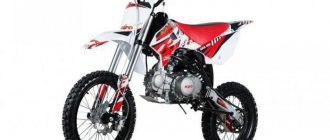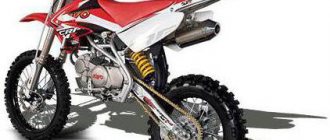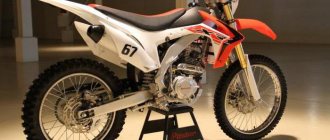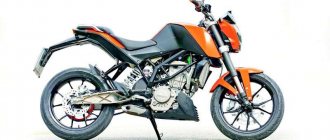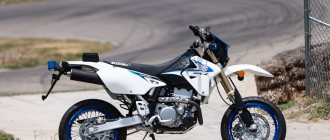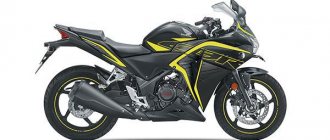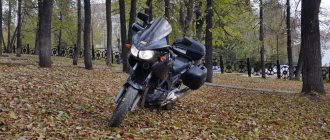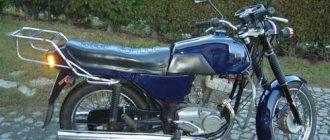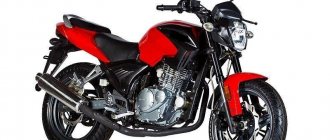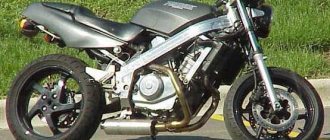Pit bikes allow you to try your hand at rough terrain. These are “miniature” motocross bikes, that is, their size is much smaller. They are suitable for both children and adults. For European countries they are commonplace. In our country, few people know about them, and even fewer have ever ridden them. A prominent representative of this category of motorcycles is the Kayo 140 pit bike. It is used to participate in various kinds of competitions (supermoto, motocross, stunt riding), enduro rides, or simply during outdoor recreation.
Manufacturer
In the nineties of the last century, a new one opened in China. And he was engaged in the production of small bikes (pit bikes). In the early years, the company produced about thirty thousand models per year. Over time, he became one of the leaders in the production of this type of motorcycle. The manufacturer offers twenty-five models of motorcycles.
The company's products have always been distinguished by affordable prices. And for the budget price category, Kayo 140 pit bikes are of good quality. Of course, there are also disadvantages. But with proper operation and timely technical inspection, the bike can last a long time. Before starting operation, immediately after purchase, it is necessary to check the quality of all components of the motorcycle. If necessary, tighten loose fasteners.
Kayo products can compete with products from European manufacturers in terms of such characteristics as controllability, build quality, ease of operation, inexpensive maintenance and repairs.
Creation
The manufacturer Kayo is considered the leader in sales of pit bikes - small motorcycles. The conveyor was built back in the 90s on the territory of the Republic of China. The quality of budget motorcycles of this type was almost ideal. But it’s still worth tightening up the components and fastenings after the purchase.
The Kayo pit bike has some weak points. If you properly care for it and repair it in a timely manner, you can eliminate all the shortcomings. A long service life is possible subject to constant monitoring of technical condition and timely troubleshooting.
Frame
The frame of the Kayo-140 pit bike is presented in the form of tubular steel profiles. The method of mounting the engine is interesting. It does not lie on the frame, but is suspended from below.
As for the steering column, it also has its own characteristics. Its angle of inclination is sharper than that of other models in this class. Due to this, maneuverability and road stability have improved.
The design of the bike includes plastic inserts. It is worth noting that this material is of high quality. It is flexible and soft enough not to break at the slightest impact.
Design
In Russia, the most popular Kayo pit bike, reviews of which are given below, is considered to be the 140 model. It is made of a steel frame and a tubular profile. The design differs from the others in that the power plant has a completely different location. The engine is suspended from below. Base size – 1225 mm, transport weight – 71 kg. The steering column is set at an acute angle, which distinguishes it from other pit bikes. Thanks to this, it was possible to make transport more maneuverable and stable.
You can purchase a motorcycle either in a regular store specializing in this type of transport or through online resources. The pit bike is transported in a special box. The buyer should assemble it by himself. The kit contains all the necessary accessories and spare parts.
Bike control
The dashboard of the Kayo-140 mini-motorcycle is simple. It is devoid of unnecessary sensors and buttons. There is only one gauge indicating the engine hours.
Standard set of handles. They all add up. In case of an accident they will not break.
On the left side of the steering column there is a button to switch the lights. Nearby is the engine start (starter) button. The classically shaped handle is also a clutch. The gas and brake are connected to the right handle.
Power unit
Kayo 140, the technical characteristics of which may surprise you, is equipped with an engine with a displacement of 140 cubic centimeters. Its power is slightly higher than that of models in this class. The engine produces fourteen horsepower at eight thousand rpm. This engine is a converted version of the well-known Honda Super Cub engine.
The engine is four-stroke. Fuel is supplied via a carburetor. The downside of the fuel system is the lack of a fuel filter. Manufacturers considered this part unnecessary. But if you refuel your bike from a canister, you can’t do without a fuel filter. Some amateurs install it immediately after the tank.
Kickstarter will help you start a pit bike. Air-oil cooling of the engine will prevent it from overheating.
Transmission
The Kayo 140 pit bike is equipped with a manual transmission with four gears. Speeds change easily and clearly. Finding neutral gear is not difficult; usually it is caught the first time. A special feature of the gearbox is its very short first speed.
The gearbox is driven by a chain drive. It would seem that a chain is more reliable than a belt. But it's not that simple. This model uses a 420 chain. During the operation of the bike, it periodically stretches. Therefore, its service life is short.
Main Dimensions
The Kayo 140 pit bike has the following dimensions:
- Wheelbase - 1.23 meters.
- The height of the saddle is 0.89 meters.
The weight of this vehicle is 71 kilograms.
The wheels are different. The front ones are seventeen inches in diameter. Rear - fourteen inches.
The fuel tank capacity is five and a half liters.
Flaws
Having described some of the advantages in the review of the Kayo 140 pit bike, it is necessary to note its disadvantages. Often this vehicle is used for off-road driving. In this case, the first disadvantage of the motorcycle appears. Users in the reviews note that when driving along trampolines, some instability is felt; the steering wheel can turn sharply if there is a strong fall. In order to avoid such an incident, it is necessary to tighten the fasteners further before performing the trick. Some buyers were spared this negative nuance, but others were eager to sell this pit bike.
The owners of this vehicle note in their reviews that sometimes the handles responsible for the braking system in the Kayo pit bike and the clutch begin to malfunction. Often they stop folding as a result of an unsuccessful fall - the fastenings simply refuse to work.
Variety of species
The manufacturer offers several versions of the Kayo pit bike with an engine capacity of 140 cubic centimeters.
Kayo 140 Classic YX140E KRZ is one of the most popular models among users. It is characterized by a four-stroke engine with a volume of 140 cubic centimeters and a power of nine and a half horsepower. Air-oil cooling system. The gearbox is four-speed. The front fork is telescopic inverted. A monoshock absorber is installed at the rear. The weight of the equipment is 71 kilograms.
The Kayo-Basic-UH pit bike has the same engine size and type as the previous model. But the output power is already 11.2 liters. With. Air-oil cooling of the carburetor. Four-speed manual transmission. Wheels are seventeen and fourteen inches. The fuel tank has a capacity of five and a half liters, which is one liter more than the previous version.
Operation and Maintenance
With proper use, Kayo 140 will last for quite a long time. But to do this, the vehicle must be monitored from the moment of purchase.
After purchase, you must carefully check all components and elements of the bike for manufacturing defects. Tighten all fasteners that need it. Running in a motorcycle must be carried out in compliance with all necessary rules. When using the bike intensively, it is necessary to change sprockets and chains regularly (once a season).
It is worth remembering that when operating a vehicle in winter conditions, special care must be taken. Decorative plastic hardens in the cold and becomes more fragile. Jumping at subzero temperatures is fraught with failure of control handles (brakes, clutch) and shock absorbers.
As for spare parts for the Kayo-140, there are no particular problems. Many details and elements are similar to other models. Therefore, if necessary, you can even replace it with parts from other bikes.
KAYO 125cc pit bikes
Three more motorcycle models are no less playful and agile than their “bigger brothers”: KAYO CRF801-7L Basic 17/14 KAYO CRF801-7L Classic 14/12 KAYO CRF801-7L Classic 17/14
Like the previous three classes of sports bikes, they have many similarities. These three motorcycles are equipped with steel rims, swingarms and handlebars. All have the same 4-stroke 125cc engine. Like the 140 cc motorcycles that were reviewed earlier, these three motorcycles differ from each other only in tires (the KAYO CRF801-7L Classic 14/12 model has smaller ones, which is actually clear even from the name), and the remaining two pit bikes are shod "in already typical tires: 14 inches at the rear and 17 inches at the front. That is, with regard to the engine, ignition, shock absorbers and suspensions, this is actually the same bike model without any differences. And now about the main difference - about accessories. Being a basic 125 cc model, KAYO CRF801-7L Basic 17/14 contains a minimal package that does not include accessories that provide the driver with additional convenience and utility. For example, this motorcycle does not have an ignition switch, which is installed in two other, more advanced bikes in this regard. This motorcycle does not have an hour meter, which is available in the other two pit bikes. An interesting fact is that the KAYO CRF801-7L Classic 14/12 motorcycle has a headlight installed by the manufacturer. That is, it can already be used as a regular vehicle for traveling in the dark.
And now a few words about the only “sports moped” that perfectly complements the variety of motorcycles in the KAYO collection. Let's start with the fact that with a cylinder volume of 49 cm3. he weighs only 56 kilograms. A kind of small and lightweight sports moped, which is a smaller copy of its older pit bike brothers. For a teenager this is it. Yes, and it is advanced - it is equipped not only with a kickstarter, but also with an ignition switch with an electric starter, as befits a respectable motorcycle. The wheels are steel rims with 10-inch tires - a typical moped design.
Kayo 140: price
One of the important indicators is the cost of a pit bike. There are two options here: buying online and buying in a salon. Each of them has its pros and cons. When purchasing Kayo-140 on the Internet, you can pay about forty thousand rubles. In the showroom the cost will be slightly higher. But in this situation, you can contact the same organization to conduct scheduled technical inspections. In similar stores, the cost of the same models can be about ten thousand more than in online stores.
Kayo 140 Disadvantages Review
Greetings to all lovers of these wonderful mopeds! We bought 6 Kayo 140 pit bikes in the month of October with some time interval. 5 motocross bikes and 1 motard bike. Since we are cross-country athletes, the test on the old cross-country track was not long in coming. But first, a preface. Having bought mopeds and brought them to the garage, they arranged a broaching. Assembly in the warehouse depends on the mood of the sellers as well as the Chinese at their factory. We stretched everything carefully, paying special attention to the rear sprocket. Although it is tightened and locked, you will be surprised that by bending the locking you can still pull and tighten the bolts. It is very important! I strongly recommend lubricating the cables, especially the clutch. The unpleasant crunch will disappear, and it will last many times longer. Next, pay attention to the steering wheel mount; then I’ll explain why. Tighten the hex bolts harder! And so they seemed to rattle at idle, then drove around without putting much strain on the engine. Not everyone, of course, held their own here, but they more or less tried to control themselves. At 5 o'clock the correct oil was added (Motul 7100). When draining the old oil, do not forget to tilt the motor so that everything is glassy from everywhere.
1) You understand that the time of year is not hot, mopeds are in the garage and are freezing. And then it turns out that the rear shock absorbers are not working! Disappointment and that's all. First one noticed, then I did. They thought that the oil boiled because of the good springboards, they say there was not enough nitrogen pumped in. And it’s true, it’s almost nothing. We pumped what was available into one - air (with a regular compressor 3-5 atm.). It seems to have worked. But the situation repeated itself almost immediately. Symptoms - knocking on rebound, feeling as if it is only working on the spring. But it actually turned out that there was a sharp reverse stroke of 5 mm with a knock, and then the shock absorber slowly, slowly moved further. Conclusion - The oil in it is very thick... not for winter and cold weather. Once you drive for a bit, the oil warms up and the operation becomes normal. Don't overdo it when it's cold - you can ruin the shock absorption. New! We decided to deal with the problem. Pump from 10 to 20 atmospheres into the shock. They suggested that there is a pump for inflating bicycle forks/shock absorbers. We look in the store - and indeed - a high pressure pump! Up to 20 atm. As a result, we download 15 and enjoy life. Even in cold weather the work is stable. This solves the problem. We will not change the oil to a less viscous one for now. 2) Strong jumps, unsuccessful landings and your steering wheel will turn in the mounts. It will not be pleasant and unexpected. This is to what was written earlier. Pull the fastener harder. But in fact, the steering wheel is bad, the fasteners are the same. 3) The brake and clutch handles are terrible. And the fact that they fold does not save them even once. The handle breaks, there is no sense in folding it. The kit costs as much as 700 rubles and constantly changing it is not the most pleasant thing. Buy protection for the steering wheel or loosen the mount on the steering wheel - if you fall, it will turn and not break. This is a standard technique. 4) Oil cooler hose. We haven’t seen anything like this anywhere on the Internet, but it started to flow. I’ll say right away that they didn’t run into anything, didn’t pull with branches, etc. It leaked at the compression point, that is, the connection with the fitting at the end. Marriage? Perhaps the Chinese cheated. But the hose can't really be found anywhere. Either order, or make a clamp, or make to order (high-pressure hoses). A very unpleasant breakdown. 5) Chain and star. The chain is stretching quite well... I feel like some of them will have to be replaced soon. We take high-quality, famous ones. The rear sprocket, despite the plate locking of the bolts, is weakened. Apply additional Loctite... or better counter, i.e. bend the plate. 6) The muffler rattled. Many have. Namely, this is the mesh at the exit of the can. She makes a nasty rattling sound. I’ll describe the treatment option, but it’s probably not the only one. New! So, remove the muffler (can). Drill out the rivets with a suitable drill and remove the cap. We see a large ring in the shape of a can, an ordinary washer of large diameter, and then the offal (stuffing and sieve tube). At the factory, the sieve tube and both rings are welded. But it’s so bad that all this is separated from each other in a couple of hours. Conclusion: you can brew it again, but I did it differently. Threw the puck away. I found a pipe literally 5 cm long so that it would fit into the sieve pipe with a slight tension. I welded the found pipe to the Big Ring (which is shaped like a can). Further, in the cap there are directly designed ebbs for the bolts. We drill holes for a bolt with M6 thread. We also drill holes in the Big Ring and weld the nuts. Now what thundered before will hold securely. Screw it to the cap. We put it on the can and secure it with new rivets. We rejoice in the silence! 7) One of us, who loves to mix mud, had his rear wheel bearings jammed. Yes, they are a closed type, but apparently the dirt, coupled with the Chinese quality, made them malfunction... they spun hard and jammed. They replaced them with new ones bought at a car store. They come from a VAZ from somewhere. The springs of the running boards and footpegs are easily lost. The ears on the ends of the springs are weak; you need to tighten them more with pliers yourself.
Yes, they are a closed type, but apparently the dirt, coupled with the Chinese quality, made them malfunction... they spun hard and jammed. They replaced them with new ones bought at a car store. They come from a VAZ from somewhere. The springs of the running boards and footpegs are easily lost. The ears on the ends of the springs are weak; you need to tighten them more with pliers yourself.
Phew, that's it. Many or few? Everyone will evaluate it differently. We looked at it from the perspective of its intended use - a cross-country track. By the way, they jump well, the suspension takes the blow. You can, of course, be tougher, but it all depends on your skill in flying high. If the Chinese immediately supplied high-quality parts (steering wheels, chains, suspensions), then the price would increase significantly, perhaps 2 times. This is approximately how racing drinks will differ from regular ones in terms of price/quality. We won’t change anything for now, but will continue to observe the experimental subjects and race them. And it will be seen there.
A lot of letters, but I hope our experience will be useful to someone. Good luck to all! PS Many people are interested in whether or not to buy such equipment; in my opinion, it is worthy of attention. The device is one of the best in its class. This is the best for beginner crossmen and stunters. A budget entry into the sport, if you have skillful hands, everything will be in chocolate. And remember, follow traffic rules and ride on the trails/areas. This is still not a scooter...
